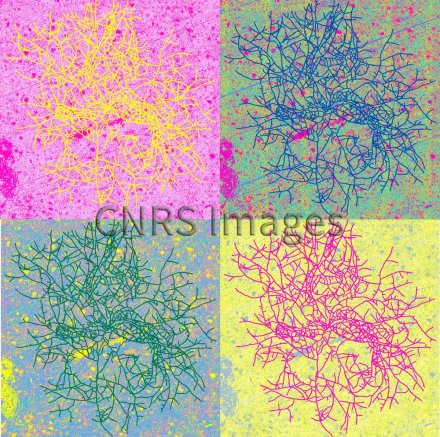Production year
2022

© C BOBEE / F CHAPELAND-LECLERC / E HERBERT / G RUPRICH-ROBERT / P DAVID / C LEDOUX / E CABET / LIED / CNRS Images
20220122_0014
Although you’re more likely to come across "Podospora anserina" on herbivore dung, this version coloured in the Andy Warhol style could well end up in a museum. Forced here to grow in two dimensions, this microscopic filamentous fungus exhibits a network of hyphae (the filaments) extending over several tens of millimetres. Such a configuration, typical of this type of organism, is thought to enable it to optimise the transmission of information as well as the management of nearby reserves, which are vital to its growth in a frequently hostile environment. In order to elucidate the formation of this network and its growth process, the scientists subject it to external constraints – thermal, nutritional, and mechanical stress – for the purpose of predictive modelling. This image is one of the winners of the 2022 La preuve par l’image (LPPI) photography competition.
The use of media visible on the CNRS Images Platform can be granted on request. Any reproduction or representation is forbidden without prior authorization from CNRS Images (except for resources under Creative Commons license).
No modification of an image may be made without the prior consent of CNRS Images.
No use of an image for advertising purposes or distribution to a third party may be made without the prior agreement of CNRS Images.
For more information, please consult our general conditions
2022
Our work is guided by the way scientists question the world around them and we translate their research into images to help people to understand the world better and to awaken their curiosity and wonderment.